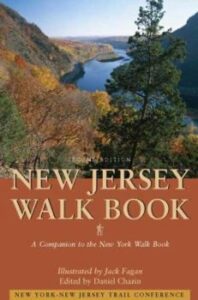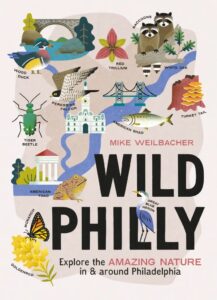I’ve previously written about  my experiences reading through historical and manuscript cookbooks for my food writing. While this is technically “research,” I honestly really enjoy it! In all actuality, I love reading through any cookbook cover to cover. There are always insightful, helpful cooking tips, personal anecdotes and historical references, something I make sure to bring into my own cookbook writing.
my experiences reading through historical and manuscript cookbooks for my food writing. While this is technically “research,” I honestly really enjoy it! In all actuality, I love reading through any cookbook cover to cover. There are always insightful, helpful cooking tips, personal anecdotes and historical references, something I make sure to bring into my own cookbook writing.
Guidebooks are another type of book I like to read in totality, particularly any focused on science and nature. Hiking and just being outside in a natural setting are among my favorite activities. Luckily my home in Bucks County, PA is a perfect jumping off spot for many outdoor excursions, whether a simple ramble on the Delaware Canal State Park towpath or a slightly longer hike at my favorite spot, Baldpate Mountain, in Hopewell Township, NJ.
When I venture out into nature, it is helpful to read about that place beforehand to get an idea of what to bring, expect, where to park, etc. Two books that have assisted me over the years (even pre-Internet!) are the New Jersey Walk Book and 50 Hikes in New Jersey. I have read both several times, using them as reference books for particular areas, skimming for ideas, and just reading cover to cover.
 Divided into fourteen chapters, the New Jersey Walk Book includes sections on various regions through the state, as well as hiker suggestions, New Jersey geology and long distance trails. It features lengthy descriptions of each region, its history, natural resources, and of course hiking and walking trails, including their length and how/where to access them. The history and science information alone are fascinating. Black and white illustrations throughout depict areas such as the Delaware Water Gap, Atlantic Highlands and Palisades Interstate Park along the Hudson, as well as wildlife from osprey and bears to lady’s slipper and mountain laurel.
Divided into fourteen chapters, the New Jersey Walk Book includes sections on various regions through the state, as well as hiker suggestions, New Jersey geology and long distance trails. It features lengthy descriptions of each region, its history, natural resources, and of course hiking and walking trails, including their length and how/where to access them. The history and science information alone are fascinating. Black and white illustrations throughout depict areas such as the Delaware Water Gap, Atlantic Highlands and Palisades Interstate Park along the Hudson, as well as wildlife from osprey and bears to lady’s slipper and mountain laurel.
The hikes in 50 Hikes in New Jersey are divided into four main regions: ridge and valley, highlands, piedmont and coastal plain. A very helpful map outlines where each hike is located within the state. At the beginning of each hike description, the total distance, hiking time, vertical rise, rating (easy, moderate, strenuous, etc.) and map key are listed. The book’s introduction includes a bit on New Jersey geology and tips on hiking in general, such as suitable clothing and trail etiquette.
I also enjoy scoping out and identifying wildlife, which is really fun with the help of phone apps such as Seek and Merlin. But although these apps provide immediate identification, they are often limited in learning more about a specific plant or animal. So I have found two books extremely helpful in providing more background about the flora and fauna in my region.

One is Wild Philly by Philadelphia area naturalist Mike Weilbacher. Chock-full of photographs and beautiful illustrations, this book is a delightful treasure trove of information about nature in and around Philadelphia. It is always amazing to find out how much wildlife really lives within urban areas, how they adapt and even thrive. Arranged into three main sections, the first part lists intriguing facts about Philadelphia area history, geography, geology and even environmental threats. The second outlines “101 species to know,” from ferns, fungi and lichens to woody and herbaceous plants, to insects, reptiles and amphibians, birds, fish and mammals. The last section highlights twenty-nine different “Field Trips” around the area, accompanied by various maps indicating location. These trips are cleverly organized by season, recommending the best time of year to view the wildlife specific to each spot. I have used it already to scope High Rocks Vista at Ralph Stover State Park (Field Trip #22) and can’t wait to check out more.
 The last book I want to reference is called Philadelphia Trees: A Field Guide to the City and the Surrounding Delaware Valley. This pocket-sized guide is perfect for stowing in my backpack or other bag when I am out and about on walks or hikes. It includes a brief history of Philadelphia’s arboreal heritage, a sizable section on the best places to see trees in the region and even fifty Philadelphia “great trees.” But the bulk of the book is a tree guide outlining each tree (including its genus/scientific name), where to find it and how to identify it through its leaves and other distinguishing features, accompanied by many helpful photographs. I really enjoyed getting more information on the Franklinia, a rare tree/bush that just so happens to grow in a historic cemetery near my house.
The last book I want to reference is called Philadelphia Trees: A Field Guide to the City and the Surrounding Delaware Valley. This pocket-sized guide is perfect for stowing in my backpack or other bag when I am out and about on walks or hikes. It includes a brief history of Philadelphia’s arboreal heritage, a sizable section on the best places to see trees in the region and even fifty Philadelphia “great trees.” But the bulk of the book is a tree guide outlining each tree (including its genus/scientific name), where to find it and how to identify it through its leaves and other distinguishing features, accompanied by many helpful photographs. I really enjoyed getting more information on the Franklinia, a rare tree/bush that just so happens to grow in a historic cemetery near my house.
Here’s a few similar guidebooks in the Rutgers Libraries collection:
- A field guide to the Pine Barrens of New Jersey: its flora, fauna, ecology and historic sites by Howard P. Boyd with a foreword by V. Eugene Vivian; illustrations by Mary Pat Finelli.
- A guide to green New Jersey: nature walks in the garden state by Lucy D. Rosenfeld and Marina Harrison
- Exploring Philly Mature: A Guide for All Four Seasons by Bernard S. Brown and Samantha Wittchen
- Nature walks in New Jersey: AMC guide to the best trails from the Highlands to Cape May by Glenn Scherer
- Vanished gardens: finding nature in Philadelphia by Sharon White
- Wonderwalks: the trails of New Jersey Audubon by Patricia Robinson